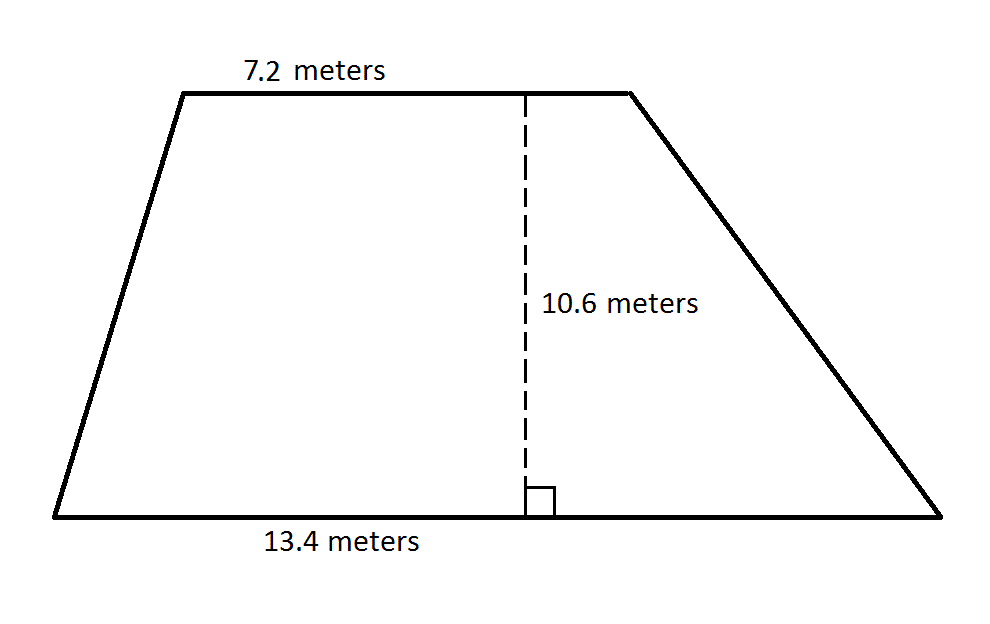All HSPT Math Resources
Example Questions
Example Question #33 : Geometry
The ratio of the length of a side of one square to the length of the side of another square is 
The area of a square can be found as follows:
Where:
So we can write:
Example Question #34 : Geometry
What is the area of a square if the length of one side is 
The area of a square is found by multiplying one side by itself.
We are given the side length, allowing us to solve.
Example Question #1811 : Hspt Mathematics

What is the area of the above trapezoid?
To find the area of a trapezoid, multiply one half (or 0.5, since we are working with decimals) by the sum of the lengths of its bases (the parallel sides) by its height (the perpendicular distance between the bases). This quantity is
Example Question #1812 : Hspt Mathematics
Find the area of the trapezoid:

The area of a trapezoid can be determined using the equation 
Example Question #1 : How To Find The Area Of A Trapezoid

What is the area of the trapezoid?
To find the area of a trapezoid, multiply the sum of the bases (the parallel sides) by the height (the perpendicular distance between the bases), and then divide by 2.
Example Question #1 : How To Find The Area Of A Triangle
A triangle has a base of 

The area of a triangle is found by multiplying the base by the height and dividing by two:
In this problem we are given the base, which is 


To solve this equation, first multply both sides by 

The left-hand side simplifies to:
The right-hand side simplifies to:
So our equation is now:
Next we divide both sides by 

So the height of the triangle is 
Example Question #1814 : Hspt Mathematics

Note: Figure NOT drawn to scale.
The above triangle has area 36 square inches. If 

The area of a triangle is one half the product of its base and its height - in the above diagram, that means

Substitute 

Example Question #6 : Triangles
Please use the following shape for the question. 
What is the area of this shape?
From this shape we are able to see that we have a square and a triangle, so lets split it into the two shapes to solve the problem. We know we have a square based on the 90 degree angles placed in the four corners of our quadrilateral.
Since we know the first part of our shape is a square, to find the area of the square we just need to take the length and multiply it by the width. Squares have equilateral sides so we just take 5 times 5, which gives us 25 inches squared.
We now know the area of the square portion of our shape. Next we need to find the area of our right triangle. Since we know that the shape below the triangle is square, we are able to know the base of the triangle as being 5 inches, because that base is a part of the square's side.
To find the area of the triangle we must take the base, which in this case is 5 inches, and multipy it by the height, then divide by 2. The height is 3 inches, so 5 times 3 is 15. Then, 15 divided by 2 is 7.5.
We now know both the area of the square and the triangle portions of our shape. The square is 25 inches squared and the triangle is 7.5 inches squared. All that is remaining is to added the areas to find the total area. Doing this gives us 32.5 inches squared.
Example Question #2 : Area Of A Triangle
What is the area of the triangle?

Area of a triangle can be determined using the equation:
Example Question #2 : How To Find The Area Of A Triangle
Bill paints a triangle on his wall that has a base parallel to the ground that runs from one end of the wall to the other. If the base of the wall is 8 feet, and the triangle covers 40 square feet of wall, what is the height of the triangle?
In order to find the area of a triangle, we multiply the base by the height, and then divide by 2.
In this problem we are given the base and the area, which allows us to write an equation using 
Multiply both sides by two, which allows us to eliminate the two from the left side of our fraction.
The left-hand side simplifies to:
The right-hand side simplifies to:
Now our equation can be rewritten as:
Next we divide by 8 on both sides to isolate the variable:
Therefore, the height of the triangle is 
All HSPT Math Resources





















































































